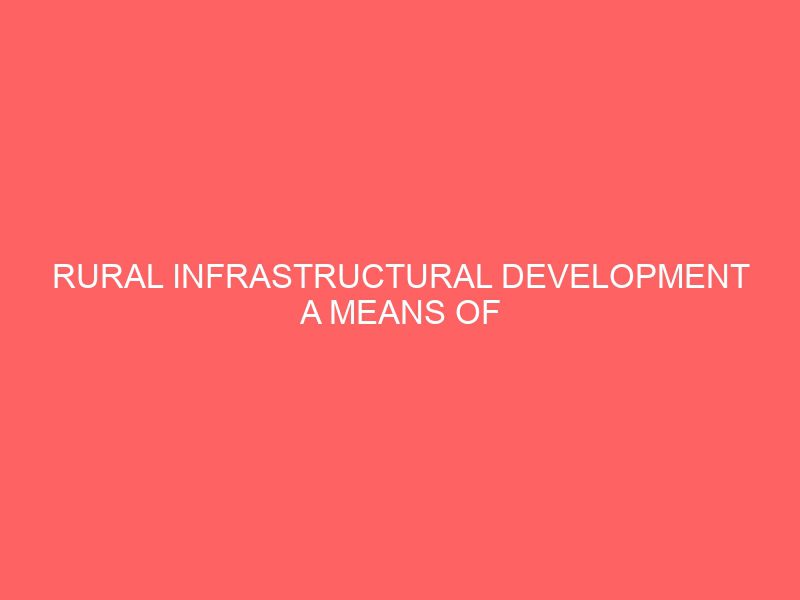Description
CHAPTER ONE
INTRODUCTION
1.1 BACKGROUND
This research is on Rural infrastructural development a means of combating rural-urban migration in Nigeria. The rural development constitute strategic sector in every nation’s economy and their rapid development and modernization have gained the attention of policy makers and government all over the world. This is because a sizeable majority of the population lives therein, therefore, the future of most countries especially the developing ones depend largely on it. Schumacher (1983) defined rural development as developing the skill of the masses to make them self-reliant through instructions which supply appropriate and relevant knowledge on the methods of self -help.
Ekpe (2006) viewed rural development as the provision of physical infrastructure. The logic that under-girds this conception is that, the provision of such basic amenities like schools, hospitals, recreational facilities, good road network, electricity and pipe-borne water (portable water) are capable of transforming the rural communities and thus make them attractive for habitation. This is contended to be the most functional way of reversing rural Urban Migration.
However, available literature on rural areas reveal that population is the main characteristic that differentiates rural from the Urban areas especially in the developed countries. Onibokun (1987) had in a policy paper on rural development revealed that rural population constitutes 70-80 % of the entire population of some countries particularly in the third world nations. Based on this single characteristic which is inadequate. Using the census figure 0f 140 million according to the national population census of 2006, over 70% of Nigeria are in the rural areas .population cannot be the only determining factor for a rural area in Nigeria because there are some features that unmistakably tell people when they are in a rural area (Ladi et al, 2009).
On the basis of this, what constitutes rural population or environment is instructive in this regard. Idike (2000) observes that the main features of rural areas are depression, degradation and deprivation. Many rural populations are immersed in poverty so palpable that the people are the embodiment of it. According to him, in many rural areas in Nigeria, basic infrastructure, where they exist at all, are too inadequate for any meaningful development. Physical infrastructures like motorable roads are often lacking. The villagers and their livestock in many rural villages depend on shallow wells or guinea worm infested ponds for their water supply. The villagers most of whom are farmers, work the land from sunrise to sunset to provide food that are cheaply bought up by middlemen (who can risk playing the usually deplorable roads) for resale to the city dwellers at very high profits.
Elaborating further, he said, in and around the villages one readily comes across children with distended tummies and spindly legs who are obvious of a better milieu from birth these ‘living that are better dead’ infants, toddler’s, youth etc. are malnutrition and they have no access to those amenities that make like worthwhile. Many rural communities in Nigeria have built schools through self-help efforts but most of the schools lack necessary teaching aids like science equipment, sitting and writing desks etc. Qualified teachers refuse serving in most of these areas because they are considered inhabitable for human beings without basic social amenities.
The above assertion is not only valid and tenable, it would be out off place to say that what constitutes rural population or environment is less than that.
The American Bureau of census classifies a group of people living in a community as rural, whereas in Nigeria, the Federal office of statistics defined a community with less than 20, 000 people as rural. According to Afolayan (1995), rural area can be easily identified by various criteria; apart from population such criteria include the level of infrastructural development i.e. road networks, educational institutions, water supply, electricity, health facilities, communication, etc. Other criteria used include occupation, housing and the extent of community policy.
In Leah et al (2013) view, rural dwellers are typically less vocal, characterized by a culture of poverty as most people have barely above subsistence level. This position tallies with that of Adefolarin (2015) who argued that rural dwellers are often a subject of poverty phenomenon, whose trade have only being robbed off by the activities of both political and economic elite’s base in the city. In other words rural dwellers in Nigeria have only little to show in attempt to alleviate the hard effects of government policies which barely acknowledge their existence but favor it with only routine care attention, with promise that are hardly fulfilled.
Ezeah (2005) states that rural areas refers to geographical areas that outside the densely built-up environment of towns, cities and the sub-urban villages and whose inhabitant are engaged primarily in agriculture as well as the most basic of rudimentary form of secondary and tertiary activities. The rural sector of Nigeria is vital to the socio-economic development of the Nation. Nyagba (2009) noted that, the most important sector of the Nigerian population is the rural areas. This according to Ugwuanyi and Emmanuel (2013) is because the rural section is the major source of capital formation for the country and a principal Market for domestic and raw materials for industries process. Abah (2010) argued that rural area dwellers have been found to engage in primary economic activities that form the foundation for the country’s economic development.
As it is conspicuously apparent from the foregoing, given the national economy, enhancing the development of the sector should be central to government and public administration. This is necessary as such would further enhance the ability of the sector for increased contribution to the overall national growth and development has become most desires in many countries in order to change and improve the situation and conations of the rural population.
Proceeding from Leah et al views, rural development has become most desires in many countries in order to change and improve the situation and conditions of the rural population.
Rural development has therefore been described in different ways by different authors, depending on the discipline or line of thought. This is because the approach to rural development is multidisciplinary. According to Aslam (1981) rural development is a process aimed at developing the rural poor, their economy and institutions from a state of stagnation or low productivity equilibrium into dynamic process leading to higher levels of living and better quality of life. In other words, rural development can be seen as a strategy which is designed to improve the economic and social life of a specific group of people, most especially the rural poor population. Aliy (199) posit that it involves extending the developmental strides and benefits people who seek a livelihood in the rural areas such as small scale farmers, tenants, artisans, school teachers, small scale business men, and traders etc. in order to improve their means of livelihood and mitigate the massive rural urban migration. However rural urban migration occurs at varying levels in every country.
According to Agyemang (2013) different motives account for rural urban migration amongst rural dwellers such as;
- socio-cultural issues where people are forced to migrate to avoid numerous social problems at their place of origin,
- Poor infrastructural development and lack of basic amenities ;
- Search for better economic opportunities such as job etc.
- Accessibility and ease of transportation and communication has also been noted to facilitate rural urban migration;
- The extension of road network from major towns to the peripheral urban and rural areas that resulted in the decrease in transportation cost and improved communication systems.
However, the situations in Nigeria as pose a discomforting problem facing this country socio-economic development. A situation where the desire for better employment, business opportunities and education push both young and old out of the rural areas to the urban areas. While the reasons for rural urban migration has it negative effect on both rural and urban environment (communities) are as follows;
- Rural urban migration considerably affect agricultural production that end up reducing food supply;
- Decline in production and manpower reduction in the rural areas;
- Slow pace of the rural areas development;
- Pressures on urban housing and the environment in general;
- High rate of population growth in the urban centers;
- Congestion and pressures on the available infrastructural amenities in the urban areas;
- Increased crime rate and insecurity in urban areas.
In addition Lykke (2002) opined that rural urban migration makes the highly educated and most agile people migrate from rural to urban areas, leaving behind the feeble and uneducated people who are not able to combat poverty successfully. This he argues consequently increases the differences in the standards of living of the rural and urban inhabitants. It is against the backdrop that I carried out this research on “Rural Development: A Means of Combating Rural Urban migration in Nigeria”.
1.2 STATEMENT OF THE PROBLEM
Incessant and excessive rural urban migration has brought about a lot of socio-economic difficulties both in the rural and urban areas. McCarthy (2004), opined that ‘excessive urbanization, lead to crime and poor infrastructure such as proper sewage disposal system, safe and potable drinking water, electricity and other amenities, chronic unemployment with the attendant creation of large slums and shanty towns. Many developing countries including Nigeria have made several attempts to resolve these problems of rural urban development. In Nigeria, from colonial period till date, successive administration have tried to reform the rural areas where over 75% of Nigeria live in for the sake of attaining balance growth and development, and discourage rural-urban migration, to no avail (Omonigho, 2013). According to Nwakeze (2004), the Nigerian population is growing at an annual rate of 2.8 percent that of the urban population growing at 5.5 percent, it is pertinent to note that this rate is among the highest in the world today.
Given the contribution of the rural section to the national economy, enhancing the development of the sector should be priority to government and relevant stakeholders.
This is necessary as such would further enhance the ability of the sector for increased contribution to the overall national growth and development. Unfortunately, over the years, the development strategies and efforts in Nigeria has been more urban based resulting in the relative neglect of rural areas evidenced by the death of basic infrastructure in the rural areas such as good roads, well equipped and functional hospitals, electricity, pipe born water etc (Abah, 2010).
The Various Government Policy Programmes such as National Accelerated Food Production Programme (NAFPP), Agricultural Development Programme (ADP), National Directorate of Employment (NDE), Primary Health Care Programme (PHCP) and many others to stem Rural Urban Migration in Nigeria. It is evident that inspite of the various programmes, Rural Urban Migration still persist.The objectives interest of this Research is to find out why the problem still persist by identifying the various programmes and the gaps and objectives of the programmes.
Most disturbing is the fact that despite the colossal amount of resources committed to those programmes, rural urban migration situation aggravates, and more and more, rural people see the need to go to the urban city. The task of this study is to find out why the gaps still exists and what solutions should be suggested to close them.
1.3 AIM AND OBJECTIVES
The general objective of this study is to determine the effect of rural development on rural urban migration. The specific objectives are:
- To determine whether rural development can serve as a panacea to stem rural urban migration.
- To find out the socio economic causes of rural urban migration.
- To determine the implications of rural urban migration on rural development.
- To identify measures put in place for rural development by government.
1.4 RESEARCH QUESTIONS
In order to enable the researcher assess the effect of rural development in combating rural urban migration in Nigeria, the following research questions are posited.
- Can rural development serve as a panacea to stem rural urban migration?
- What are the socio-economic causes of rural urban migration?
- What are the consequences of rural urban migration on rural development?
- What measures are put in place by government to develop the rural areas?
1.5 HYPOTHESES
In order to enable the researcher assess the effect of rural development in combating rural urban migration in Nigeria, the following hypotheses will be tested:
- Ho: Rural development does not have any influence on rural urban migration in Nigeria
HA: Rural development has an influence on rural urban migration in Nigeria.
1.6 SIGNIFICANCE OF THE STUDY
The study will aid government agencies such as town planners at various tiers of government in formulating policies that will accelerate development in rural areas in order to reduce rural urban migration.
This research study will also help reveal the extent of the problem to relevant stakeholders so that they can rise to the occasion and put in measures to the occasion and put in measures to develop the rural areas in order to reduce rural urban migration. Finally, this research work will add to the existing body of knowledge on the importance of rural development in combating rural urban migration in Nigeria.
1.7 JUSTIFICATION AND SCOPE OF STUDY
This study will cover rural development and its impact on combating rural urban migration in Nigeria with special reference to the actual influence it has on the socio-economic activities and lives of rural dwellers, measures put in place by relevant stakeholders to combat the measures of rural urban migration in the study area.
Therefore, it is important that rural development strategies are thoroughly debated in terms of it contribution to reduce rural urban migration. This study is a contribution to the debate.
1.8 RESEARCH METHODOLOOGY
The study use two approach that have survey research methodology and the formation are;
- Content analysis for secondary data collection
- Survey research method for primary data collection.
1.9 ORGANIZATION OF THE STUDY
This study is organized into five chapters. The first Chapter of this study includes the general introduction, background to the study, statement of the problem, objectives of the study, research questions, hypothesis, scope of the study, significance of the study, methodology, organization and the definition of terms.
Chapter two reviews all relevant literatures relatively to the study and concluded with a theoretical framework.
Chapter three is basically research methodology
Chapter four focus on the presentation and analysis
Chapter five includes a summery of the study, conclusion and recommendation based on the finding from the study.
1.10 DEFINITION OF TERMS AND CONCEPTS
Rural Area: a geographical area located outside cities and towns with relatively low population density and small settlements.
Migration: movement of people across a specified boundary for the purpose of establishing a new or semi- permanent residence.
Rural development: the process of improving the quality of life and economic well being of people living in relatively isolated area.
Rural urban migration: is a process of population shift from rural areas to urban areas with attendant increase in proportion of people living in urban areas
Infrastructure: basic physical and organizational structure and facilities needed for the operation of a society or enterprise.
Effect/Impact: outward result of something that is either positive or negative in the society.







